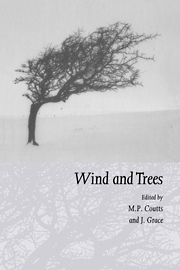Book contents
- Frontmatter
- Contents
- Preface
- List of contributors
- Part I Airflow over topography and in forests
- Part II Mechanics of trees under wind loading
- Part III Tree physiological responses
- Part IV Impacts of wind on forests and ecology
- Part V Risk assessment and management response
- 21 Assessing the risk of wind damage to forests: practice and pitfalls
- 22 Forest wind damage risk assessment for environmental impact studies
- 23 Recommendations for stabilisation of Norway spruce stands based on ecological surveys
- 24 Thinning regime in stands of Norway spruce subjected to snow and wind damage
- 25 A synopsis of windthrow in British Columbia: occurrence, implications, assessement and management
- 26 Wind damage to New Zealand State plantation forests
- 27 The experience of and management strategy adopted by the Selwyn Plantation Board, New Zealand
- Index
26 - Wind damage to New Zealand State plantation forests
Published online by Cambridge University Press: 27 October 2009
- Frontmatter
- Contents
- Preface
- List of contributors
- Part I Airflow over topography and in forests
- Part II Mechanics of trees under wind loading
- Part III Tree physiological responses
- Part IV Impacts of wind on forests and ecology
- Part V Risk assessment and management response
- 21 Assessing the risk of wind damage to forests: practice and pitfalls
- 22 Forest wind damage risk assessment for environmental impact studies
- 23 Recommendations for stabilisation of Norway spruce stands based on ecological surveys
- 24 Thinning regime in stands of Norway spruce subjected to snow and wind damage
- 25 A synopsis of windthrow in British Columbia: occurrence, implications, assessement and management
- 26 Wind damage to New Zealand State plantation forests
- 27 The experience of and management strategy adopted by the Selwyn Plantation Board, New Zealand
- Index
Summary
Abstract
New Zealand's conifer plantations have suffered at least 50000 ha of catastrophic wind damage. This is wind damage to stands over 5 years of age where most stems are either windthrown or broken. Damaged areas have ranged in size from around 1 ha to up to many thousand hectares, and where these have occurred in mature or semi-mature plantation they have usually been harvested. Also of major importance has been continuing attritional wind damage resulting from lesser winds. This is scattered endemic damage which is rarely recoverable. Quantification of the risk of wind damage is important when considering profitability, yield and cash flow projections. For 17 previously State-owned forests, where past wind damage events have been documented, risk of catastrophic wind damage was calculated as the average percentage of net stocked area lost per year. This work considered 50 years of records documenting 30 860 ha of catastrophic wind damage within the 259950 ha of softwood plantations. Estimates of attritional losses to stands over 14 years of age have been obtained from the extensive permanent growth sample plots located throughout these forests. The overall forest catastrophic and attritional levels of damage were found to be 0.38% and 0.25% of net stocked area lost per annum respectively. These data correspond to an average 12% of forest area lost over a 28 year rotation. While the least-affected forests would lose only 5–6%, the worst-affected would lose most of its stocked area. Forests subjected to high windspeeds associated with upwind mountainous terrain have had far greater levels of wind damage.
- Type
- Chapter
- Information
- Wind and Trees , pp. 460 - 467Publisher: Cambridge University PressPrint publication year: 1995
- 5
- Cited by



